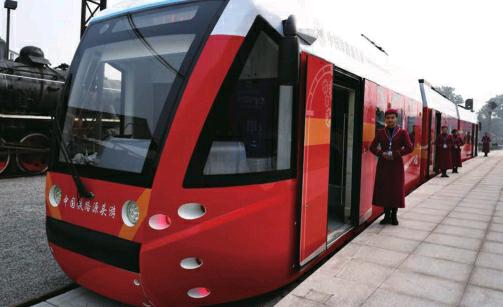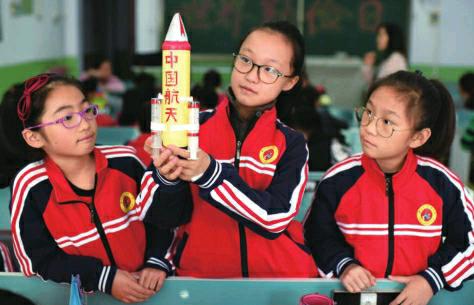Dressing up to Celebrate
2017-11-27
Women of the Miao ethnic group prepare for the Chixin Festival, a traditional harvest celebration, in Paimo Village in Danzhai County, southwest Chinas Guizhou Province, on October 30.
Second Child
In the fi rst eight months of this year, more than half of Chinas newborn babies were the second child in the family, according to a senior health offi cial.
From January to August this year, about 52 percent of the 11.6 million babies born had an older sibling, said Wang Peian, Vice Minister of the National Health and Family Planning Commission(NHFPC), at a demography forum in Beijing on October 30.
Figures provided by the NHFPC showed that 18.5 million babies were born in hospital in 2016, the highest number since 2000 and 1.3 million more than in 2015. About 45 percent of them had an older sibling.
In response to the aging of its population, China has since 2016 removed all restrictions on second child.
Wang also said that even with an increased average age of expectant mothers, newborn and maternal mortality have fallen.
There will be changes to policies in tax, social security, housing, employment and other areas as well as more support for the new family planning policy, said Wang.
In 2016, China allocated 2.9 billion yuan ($440 million) for construction of city- and prefecture-level maternity and pediatric hospitals.
By 2020, there will be around 89,000 new maternity beds in hospitals and 140,000 more obstetricians and midwives. More emergency centers for mother and child treatment will be set up across the country by the end of the year, according to a government plan.
Online News
The Cyberspace Administration of China (CAC) on October 30 issued two regulations to strengthen the management of online news services.
One of the regulations requires online news providers to provide more training for and strengthen supervision of their staff.
The CAC will also set up a management system for online news editors, which will include a blacklist.
The other document deals with a security evaluation mechanism for the use of new technology in new online services.
It requires service providers to conduct such evaluations before the introduction of new technology or applications in their platforms.
The CAC regulation also stipulates safeguard measures for information security. Both rules will go into effect on December 1.endprint
Creative Cities
The United Nations Organization for Education, Science and Culture(UNESCO) has picked four Chinese cities to join its Creative Cities Network (UCCN), the organization said on October 31.
Created in 2004, the UCCN covers seven creative f eilds, namely Crafts & Folk Art, Design, Film, Gastronomy, Literature, Music and Media Arts.
The four Chinese cities—Changsha (media arts), Macao Special Administrative Region(gastronomy), Qingdao (f lim) and Wuhan (design)—are among 64 cities from 44 countries and regions that join the network.
UNESCO said the four Chinese cities were picked for their efforts to“develop and exchange innovative best practices to promote creative industries, strengthen participation in cultural life and integrate culture into sustainable urban development policies.”
The Paris-based UN body said in a statement that “within the framework of the implementation of the United Nations 2030 Agenda for Sustainable Development and the New Urban Agenda, the Network provides a platform for cities to demonstrate cultures role as an enabler for building sustainable cities.”
Women Report
A majority of students in Chinas higher education institutions are female, and the number of women in the workforce has also increased, data from the National Bureau of Statistics showed.
In 2016, 50.6 percent of postgraduate students were female, exceeding the percentage of men for the fi rst time. The same year women also accounted for 52.5 percent of college students.
Some 43.1 percent of the coun-trys workforce was female at the end of 2016, with the number of female workers in urban regions reaching 65.18 million, up 34 percent from 2010.
There was also improvement in the gender imbalance in decision making, in both politics and business.
The ratio of female deputies to the 12th National Peoples Congress, the top legislature, reached a record high of 23.4 percent, 2.1 percentage points higher than the previous congress fi ve years ago. Women accounted for 39.9 percent of the members of boards of directors in 2016, compared with 32.7 percent in 2010.
Garbage Treatment
Beijing plans to end the burying of untreated household garbage by 2020.
Currently, Beijing can deal with 23,800 tons of household trash every day, and the amount is expected to climb to 30,000 tons by 2020, according to Beijings City Management Commission.
Garbage from the capital used to be sent to landfi lls without being treated. Now, it is mainly incinerated or broken down by microorganisms.endprint
Two new garbage incinerators are planned for Mentougou and Daxing districts.
An incinerator in Daxing, which started trial operations four months ago, can deal with 1,000 tons of trash a day.
Emission levels from the incinerator were designed to meet both national and local standards, said Zhang Yuesheng with the commission. “Some levels even meet the standards of the EU.”
Making Headway
A China-made tram powered by hydrogen fuel cells is put into commercial operation in Tangshan, north Chinas Hebei Province, on October 27.
Produced by China Railway Rolling Corporation (CRRC) Tangshan Co. Ltd., it is the worlds fi rst commercial hydrogen-powered tram.
Water Source
The Danjiangkou Reservoir on the Hanjiang River, a major tributary of the Yangtze, has stored much more water this year due to autumn fl oods, guaranteeing the water supply for the south-to-north water diversion project.
The water level of the reservoir in central Chinas Hubei Province reached 167 meters on October 29, 6.28 meters higher than the previous record level, according to the Yangtze River Flood Control Headquarters.
Currently, the reservoir stores 26 billion cubic meters of water, 10.7 billion cubic meters more than it did at the same time last year.
The hydropower station is in normal operation. The increased water volume guarantees the water supply for the middle route of the south-to-north water diversion project, which opened in 2014.
The middle route of the project carries water through canals and pipes from Danjiangkou to the cities of Beijing and Tianjin and the provinces of Hebei and Henan.
Smart Firefighting
The Ministry of Public Security has issued a guideline to promote “smart fi refi ghting.”
According to the document, new surveillance systems will connect more buildings and improve functions like automatic fi re alarms, inspections and supervision.
The new remote surveillance systems will be able to recognize images of fi re and smoke, set off alarms and monitor the conditions of fi refi ghting facilities, it stated.
The systems will also monitor electricity leakage and cable temperatures.
Information resources including live images of fi res, the locations of fi refi ghting teams and major sources of danger near fi re sites should be collected and maintained on a command platform for public security departments by the end of 2018, said the guideline.endprint
High-rise buildings under construction should be installed with the new surveillance systems, and old buildings should be fi tted with separate fi re alarm and fi refi ghting facilities, it added.
Cities at prefecture level and above are required to complete building the new systems by the end of 2018.
Transforming Waste
Students use recycled materials to make handicrafts at a primary school in Hengshui City, north Chinas Hebei Province, on October 31.
PMI
Chinas manufacturing sector expanded at a slower but stable pace in October, according to offi cial data on October 31.
The manufacturing purchasing managers index (PMI) came in at 51.6, moderating from 52.4 in September and 51.7 in August, according to the National Bureau of Statistics (NBS).
A reading above 50 indicates expansion, while one below refl ects contraction.
NBS statistician Zhao Qinghe attributed the slowdown in expansion to a high base in September and the infl uence of Octobers weeklong public holiday. “The growth in production and market demand eased,” he said.
On the other side, Chinas nonmanufacturing sector continued steady expansion in October.
The non-manufacturing PMI came in at 54.3 in October, slightly down from 55.4 in September but still in expansionary territory, according to the NBS.
The services sector, which accounted for more than half of the countrys GDP, continued steady growth, with its business activity index standing at 53.5 in October, NBS data showed.
Spurred by the week-long public holiday in October, industries such as accommodation, retail, rail and air transportation, logistics, tourism and Internet services witnessed relatively fast growth, said Zhao.
However, the business activity index for producer services dropped to 52.3 due to a slowdown in the expansion of the manufacturing sector in October, Zhao said.
Internet Plus Manufacturing
China will speed up the development of Internet Plus advanced manufacturing to boost innovation and entrepreneurship as well as integration between enterprises of various sizes to enable further upgrading of the economy.
The decision was made at a State Council executive meeting chaired by Premier Li Keqiang on October 30.
The integration between the Internet and the real economy will be further deepened, and the development of the Industrial Internet will be accelerated through the implementation of the Made in China 2025 strategy in an effort to transform the nation into a global leader in the Industrial Internet, according to the decision made at the meeting.endprint
“Pushing forward Internet Plus advanced manufacturing is an important measure to enable the transformation and upgrading of the real economy. China owes the fast development of its new growth engines to its abundant human resources and talent, vast market and prudent yet accommodating government oversight,” Li said.
“We should create a vibrant and enabling environment for Internet Plus advanced manufacturing by further streamlining administration, enhancing compliance oversight and improving government services. This will enable the Industrial Internet to develop in a more open and integrated manner, and put China at the forefront of the new round of industrial revolution,” Li said.
Upgrading Made-in-China
A worker examines the functions of an intelligent toilet seat cover in a factory in Taizhou, east Chinas Zhejiang Province on November 1.
So far, there have been nine intelligent toilet seat cover manufacturers in Taizhou, with total output reaching 4 billion yuan ($604 million) in 2016.
Qingdao-Sydney Air Route
A direct air route opened on October 29 between east Chinas coastal city Qingdao and Sydney, Australia to meet tourism and business demand.
Beijing-based Capital Airlines will operate the route with four fl ights per week from Qingdao, Shandong Province, to Sydney—on Monday, Wednesday, Friday and Sunday—using Airbus A330 widebody aircraft.
Capital Airlines, a joint venture between HNA Group and Beijing Tourism Group, launched a direct fl ight between Qingdao and Melbourne in September 2016, the fi rst direct air link between Shandong and Australia.
Australia is an important source of visitors for the Chinese province and also a popular destination for Shandong tourists.
Anti-Dumping Probe
The Chinese Ministry of Commerce said on October 30 that it has started an anti-dumping investigation into ethanolamine imported from the United States, Saudi Arabia, Malaysia and Thailand.
The ministry received a joint application requesting an inquiry from six domestic producers, who accuse foreign manufacturers of dumping the product on the Chinese market, according to an offi cial statement.
The combined ethanolamine output of the six applicants accounted for more than half of the countrys total during the 2014-16 period.
The ministry will investigate whether foreign companies from the four countries have sold the product in China at an artifi cially low price.endprint
The investigation should be concluded by October 30 next year, but, in special circumstances, may be extended to April 30, 2019, according to the statement.
A New Way to Affluence
Farmers sort winter peaches in Jingxian County, Hebei Province, on October 31. In recent years, Jingxian has committed itself to promoting the transformation of local agriculture and traditional planting patterns.
Moutai Airport Opened
An airport named after Chinas national liquor, Moutai, opened in southwest Chinas Guizhou Province, Moutai Group announced on October 31.
Moutai Airport is located in Moutai Township in Renhuai City. Flights link the airport with cities including Beijing, Tianjin, Chengdu of Sichuan Province, Fuzhou of Fujian Province, Xian of Shaanxi Province and Haikou of Hainan Province.
Construction of the airport cost 2.4 billion yuan ($360 million) and took fi ve years.
The number of air routes linking Moutai with cities around China will be expanded to 18 in the near future, the group said.
In 2016, Moutai saw its output reach around 60,000 tons, with sales revenue surpassing 38.8 billion yuan ($5.87 billion) and net profi t reaching 16.7 billion yuan ($2.52 billion), up 18.99 percent and 7.84 percent, respectively, year on year.
Mining Joint Venture
Russian mining giant Norilsk Nickel said on October 31 that it has begun commissioning its joint-venture processing plant with a Chinese partner in Bystrinsky, a district near Russias far-eastern border with China.
Highland Fund, a consortium of Chinese investment funds and corporations, has a 13.3-percent stake in the project. The plant will process ore from the Bystrinsky gold-ironcopper deposit, one of the 10 largest copper deposits in the world, to produce copper, gold and magnetite concentrates.
Full-scale operation is expected to start by mid-2018, a Norilsk Nickel statement said. Its annual design capacity of 10 million tons of ore will be reached by the end of 2019.
The construction of the Bystrinsky plant has become the largest greenfi eld project in the Russian metals and mining sector. It is expected to become a major employer in the Trans-Baikal Territory and generate over 3,000 jobs.
Norilsk Nickel, a leading producer of refi ned nickel and platinum group metal palladium, also produces copper, platinum and other non-ferrous metals.
Rural Tourism
China wants to develop tourism in rural areas to help lift more people out of poverty, as the government has identifi ed poverty eradication as the key task in building a moderately prosperous society by 2020.endprint
China aims to lift 12 million people out of poverty through tourism from 2016 to 2020, according to the China National Tourism Administration (CNTA).
In southwest Chinas Guizhou Province, authorities have identifi ed thousands of potential tourism resources and supported 14 impoverished counties to build tourist areas.
The projects have helped 70,000 villagers raise their incomes to above the provincial poverty line, according to the CNTA.
Across the country, local governments have mobilized resources and pumped funding into improving infrastructure and services in rural areas to facilitate the development of tourism.
China has set 2020 as the target year for completing the building of a moderately prosperous society, which requires the eradication of poverty.
As of the end of 2016, there were 43.35 million Chinese living below the national poverty line.
Multi-Use Delivery Containers
Reusable delivery boxes move through a logistics warehouse in Nanjing, Jiangsu Province, on October 31.endprint
